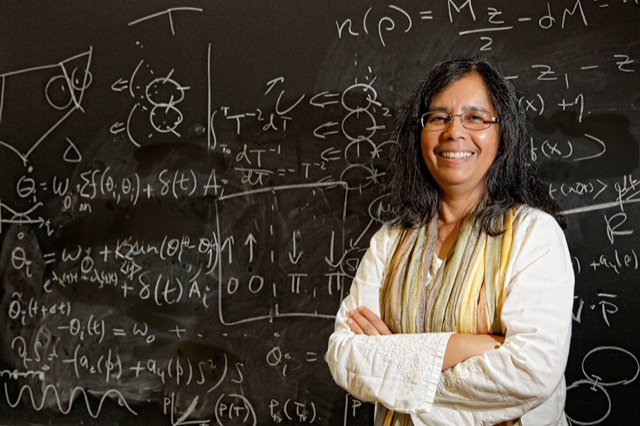 Professor Bulbul Chakraborty of Brandeis University
Professor Bulbul Chakraborty of Brandeis University
Photo by Mike Lovett
Bulbul Chakraborty, a former KITP Advisory Board member and chairperson, is the Enid and Nate Ancell Professor of Physics at Brandeis University. She participates regularly in KITP programs on soft matter and non-equilibrium systems, and in October 2019 I sat down to interview her about the Institute’s contribution to those fields. Chakraborty was at KITP for a follow-on – two weeks of focused work with collaborators from the 2018 Physics of Dense Suspensions program she co-coordinated. Since she studies systems governed by classical behavior, I was surprised to hear her excitement about the quantum condensed matter conference in house that week.
Chakraborty explained that, in fact, this classical-to-quantum link is consistent with a scientific transition she made over 20 years ago. For the first 15 years of her academic career, Chakraborty specialized in hard condensed matter, material systems governed by quantum mechanics and atomic or molecular interactions. She primarily studied quantum spin liquids - strange magnetic materials that do not exhibit the usual type of magnetic order.
In the mid-1990’s, she and other physicists studying quantum spin liquids realized that the materials had important connections with glasses (materials that are solid despite their molecular disorder) and began to study the latter. That shift led her to spend most of fall 1997 at the ITP program “Jamming and Rheology” which gathered dozens of physicists and engineers to develop a coherent framework for modeling granular systems, foams, and glasses. Jamming is when a granular material transitions from flowing like a liquid to acting like a solid—you’ve encountered this if your coffee beans have ever gotten stuck in the funnel of a grinder.
She says that the timely program led to two major paradigm changes: the concept of an effective temperature in glasses and a now-famous jamming phase diagram with density, temperature, and load as the three axes. This phase diagram was remarkable in that it integrated the physics of glassiness and jamming by including a variable, load, which is not part of any equilibrium phase diagram.
Why did it happen at ITP? She credits the ease of communication that can only exist when a diverse group of scientists assembles for an extended period. “Just going along the corridor and finding someone makes a huge difference.”
A few years after the program, a chance interaction pushed her further into classical physics, helping to redirect her research focus into granular systems. She was visiting Sid Nagel at the University of Chicago when she encountered a postdoc who was trying to make sense of a paper on jamming. Chakraborty recalls thinking, “This is exactly what I did in the quantum spin systems; maybe this actually applies here!’” Superficially, the systems have little in common, but she realized that the electrons in a quantum spin liquid and the macroscopic particles in a granular solid are under very strong constraints that may be usefully analogized.
For the subsequent 15 years, Chakraborty continued using tools borrowed from quantum materials to study classical systems. In 2018, she co-coordinated a KITP program on dense suspensions which, like granular materials, jam under shear stress. Like the 1997 jamming program, the Physics of Dense Suspensions program brought together physicists, engineers, and chemical engineers. The group grounded in traditional fluid dynamics viewed the intriguing phenomena in dense suspensions from that perspective, whereas the community grounded in statistical mechanics and granular physics emphasized the particulate aspects of the systems. The productive tension between their models of these materials “really changed the course of the study of these materials,” she enthused.
In the last 3-4 years, models of spin liquids have advanced rapidly and are now mature enough to provide the sort of insights Chakraborty seeks. “There were bits and pieces, but the full framework had not been constructed . . . At this point, I think we know the connection and we can learn a lot from the quantum spin liquids to understand these frictional systems.”
Chakraborty continues to see KITP programs as an extremely efficient way to get into a new field. “Just that whole model of where you could freely exchange ideas and you could actually jump into new fields…that has been a huge thing for me.”
- Maggie Sherriffs, Special Programs and Evaluations Manager, KITP
KITP Newsletter, Spring 2020
